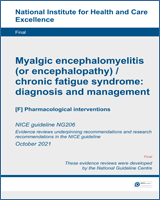From: Pharmacological interventions

NCBI Bookshelf. A service of the National Library of Medicine, National Institutes of Health.
| Outcomes | No of Participants (studies*) Follow up | Quality of the evidence (GRADE) | Relative effect (95% CI) | Anticipated absolute effects | |
|---|---|---|---|---|---|
| Risk with | Risk difference with Children and young people: Central antihypertensive drugs (clonidine) versus placebo (95% CI) | ||||
|
Fatigue: Chalder Fatigue Questionnaire (CFQ) total sum score Scale from: not reported. |
103 (1 study) 30 weeks |
⊕⊝⊝⊝ due to risk of bias, indirectness, imprecision |
The mean fatigue: chalder fatigue questionnaire (cfq) total sum score at 30 weeks in the control group was 13.5 |
The mean fatigue: chalder fatigue questionnaire (cfq) total sum score at 30 weeks in the intervention groups was 0.5 higher (14.7 lower to 15.7 higher) | |
|
Physical functioning: Fatigue Disability Index (FDI) total sum score Scale from: not reported. |
103 (1 study) 30 weeks |
⊕⊝⊝⊝ due to risk of bias, indirectness, imprecision |
The mean physical functioning: fatigue disability index (fdi) total sum score at 30 weeks in the control group was 16.8 |
The mean physical functioning: fatigue disability index (fdi) total sum score at 30 weeks in the intervention groups was 0.2 higher (13.3 lower to 13.7 higher) | |
|
Pain: BPI average pain score Scale from: 0 to 10. |
103 (1 study) 30 weeks |
⊕⊝⊝⊝ due to risk of bias, indirectness, imprecision |
The mean pain: bpi average pain score at 30 weeks in the control group was 3.3 |
The mean pain: bpi average pain score at 30 weeks in the intervention groups was 0.4 higher (0.4 lower to 1.2 higher) | |
|
Sleep quality: KSQ insomnia score Scale from: not reported. |
103 (1 study) 30 weeks |
⊕⊝⊝⊝ due to risk of bias, indirectness, imprecision |
The mean sleep quality: ksq insomnia score at 30 weeks in the control group was 3.6 |
The mean sleep quality: ksq insomnia score at 30 weeks in the intervention groups was 0.1 higher (0.3 lower to 0.5 higher) | |
| Adverse effects: various self-reported |
108 (1 study) 9 weeks |
⊕⊝⊝⊝ due to risk of bias, indirectness, imprecision | RR 1.17 (0.91 to 1.5) | 647 per 1000 |
110 more per 1000 (from 58 fewer to 324 more) |
| Activity levels: steps per day (accelerometer) |
103 (1 study) 30 weeks |
⊕⊕⊝⊝ due to risk of bias, indirectness |
The mean activity levels: steps per day (accelerometer) at 30 weeks in the control group was 4652 |
The mean activity levels: steps per day (accelerometer) at 30 weeks in the intervention groups was 119 higher (796 lower to 1034 higher) | |
|
Cognitive function: Digit span backward test total Scale from: not reported |
103 (1 study) 30 weeks |
⊕⊝⊝⊝ due to risk of bias, indirectness, imprecision |
The mean cognitive function: digit span backward test total at 30 weeks in the control group was 6.7 |
The mean cognitive function: digit span backward test total at 30 weeks in the intervention groups was 0.5 lower (1.2 lower to 0.2 higher) | |
|
Symptom scales: CFS symptom inventory hypersensitivity score Scale from: not reported |
103 (1 study) 30 weeks |
⊕⊕⊝⊝ due to risk of bias, indirectness |
The mean symptom scales: cfs symptom inventory hypersensitivity score at 30 weeks in the control group was 2.6 |
The mean symptom scales: cfs symptom inventory hypersensitivity score at 30 weeks in the intervention groups was 0.03 lower (0.4 lower to 0.34 higher) | |
Downgraded by 1 increment if the majority of the evidence was at high risk of bias, and downgraded by 2 increments if the majority of the evidence was at very high risk of bias
The majority of the evidence included an indirect population (downgraded by one increment): downgraded if the ME/CFS diagnostic criteria used did not include PEM as a compulsory feature [original analysis]; percentage of participants with PEM unclear [PEM reanalysis – see Appendix G for additional details]
Downgraded by 1 increment if the confidence interval crossed one MID or by 2 increments if the confidence interval crossed both MIDs
Outcome indirectness: Some adverse effects are poorly defined, e.g. “unwellness” and “other”
Studies included: Sulheim 2014
From: Pharmacological interventions

NCBI Bookshelf. A service of the National Library of Medicine, National Institutes of Health.